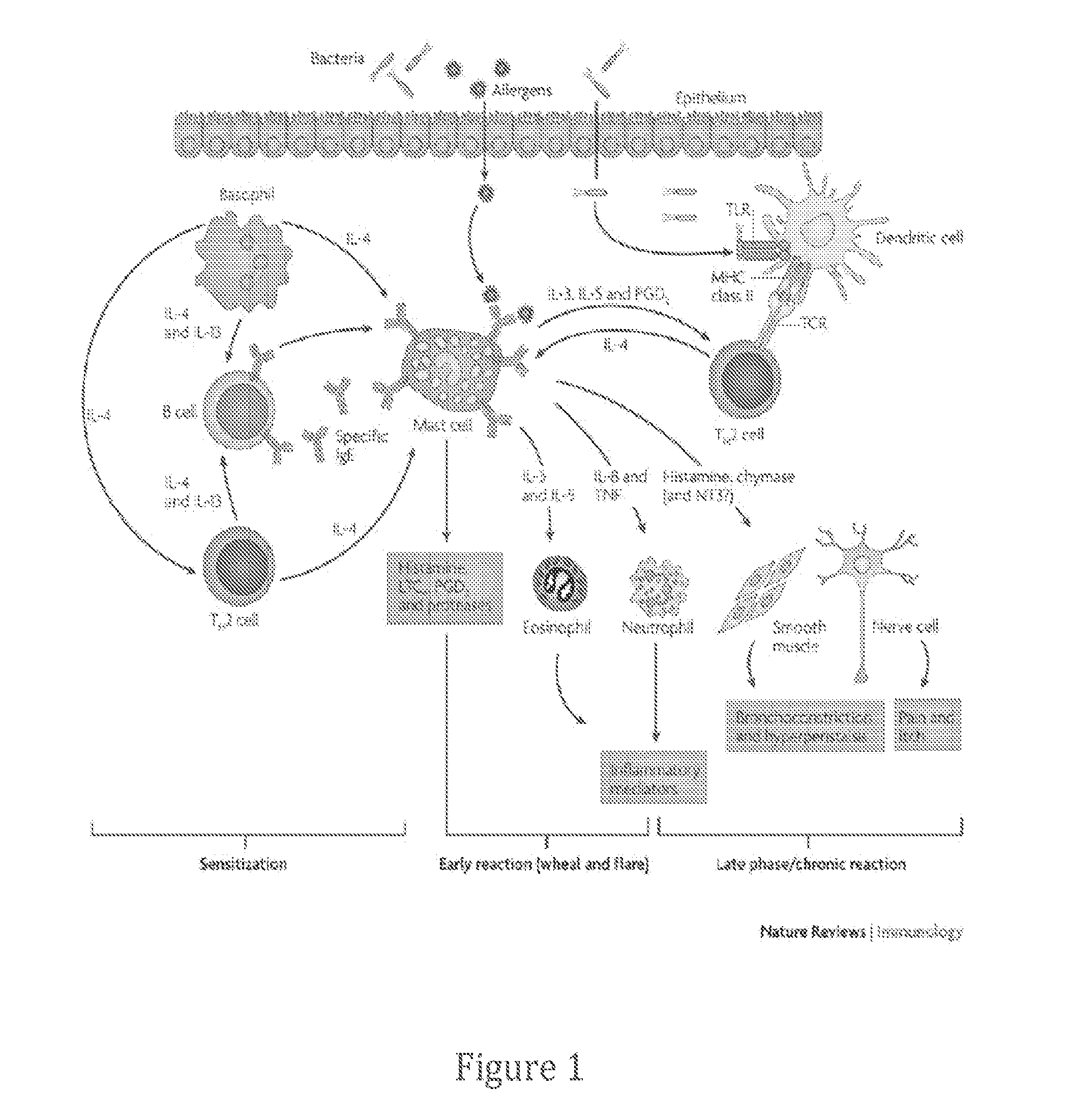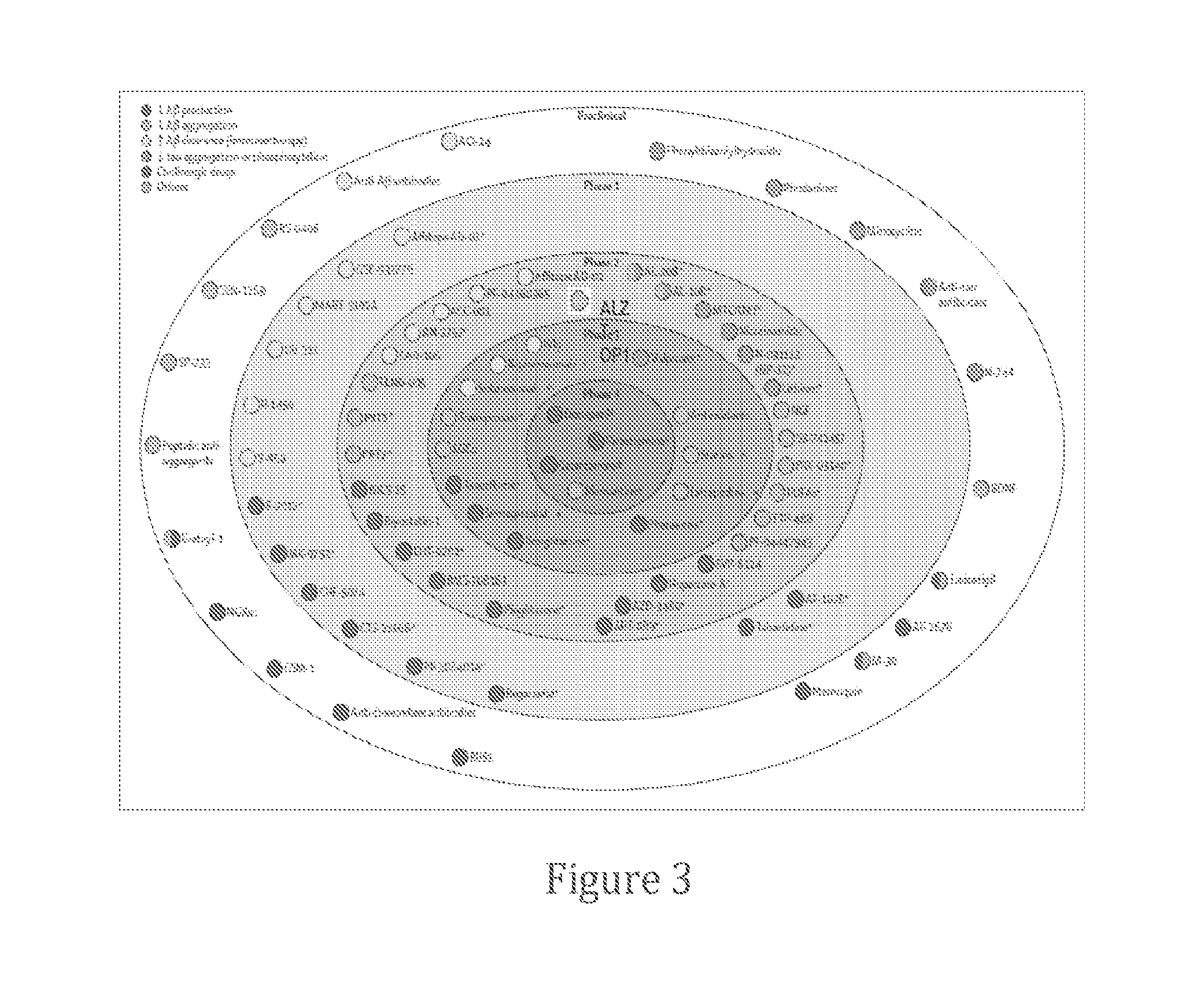Combination therapies for the treatment of alzheimer's disease and related disorders
a combination therapy and alzheimer's disease technology, applied in the direction of immunoglobulins against animals/humans, drug compositions, amine active ingredients, etc., can solve the problems of cell death, malfunction of biochemical communication between neurons, and disruption of neuronal communication, so as to and improve cognitive function, mood, or social behavior
- Summary
- Abstract
- Description
- Claims
- Application Information
AI Technical Summary
Benefits of technology
Problems solved by technology
Method used
Image
Examples
example 1
Cromolyn and Ibuprofen Combination Treatment
[0162]The following is a dosing example calculation for cromolyn:[0163]1. Effective comolyn administration for AD treatment is significantly different from that of cromolyn for lung inflammation and asthma. For lung inflammation or asthma subjects use inhalation devices 1-4 times per day; each inhaled dose contains 20 mg of dry powder.[0164]2. The dry cromolyn powder (usual size is >5 microns) is formulated with lactose with much larger size.[0165]3. When inhaled, dry cromolyn powder is separated from the lactose via the inhaler device action (spinhaler, cyclohaler, or monodose inhalers) or in the upper part of the airway and the dry cromolyn is delivered to the lung.[0166]4. Cromolyn has also been delivered as a solution that enters via the gastric system.
[0167]For AD, these treatments will not result in any significant action on AD progression or modification.
[0168]For AD treatment, to be effective, the drug has to be delivered systemica...
example 2
In Vivo Experiments of Cromolyn and Ibuprofen Combination Treatment
[0173]Three mice groups (five animals in each) were tested in a Morris water navigation test. Two groups were four months young APP / PS1 including a mutant Aβ mouse and a model indicative of Alzheimer's Disease progression. One APP / PS1 group was treated with Cromolyn and ibuprofen combination for six months, and the second was untreated as an control group and a third untreated wild type was used as a normal control. FIG. 1 is a graph showing the in-vivo study summary. WT (wild type, right panel) shows normal untreated mice. The control group (left panel) shows transgenic mice that did not received drug treatment. The treated group (Mid panel) shows transgenic mice that received AZLT-OP1(cromolyn+ibuprofen) for six month by Intraperitoneal (IP) injection twice weekly. Mice were trained for 7 days to remember the location of the platform. At day 8, the platform was removed, and the times of crossing the platform area w...
example 3
Cromolyn Derivatives for Inhibiting Polymerization of Alzheimer's Disease Oligomers and Treating Alzheimer's Disease
[0180]In another experiment, cromolyn derivatives were tested as inhibitors of Aβ polymerization. Inhibiting Aβ oligomer production will provide of Alzheimer's Disease and treating Alzheimer's Disease.
[0181]The investigational product ALZT-OP1a (cromolyn sodium) is a synthetic chromone derivative that has been approved for use by the FDA since the 1970s for the treatment of asthma. For asthma treatment, cromolyn sodium powder was micronized for inhalation to the lungs via dry powder inhaler, i.e. the Spinhaler device. Liquid intranasal and ophthalmic formulations have also been developed for the treatment of rhinitis and conjunctivitis.
[0182]The mechanism of action for cromolyn sodium (ALZT-OP1a) is characterized as a mast cell stabilizer, namely to suppress cytokine release from activated lymphocytes together with preventing the release of histamine from mast cells (N...
PUM
| Property | Measurement | Unit |
|---|---|---|
| weight | aaaaa | aaaaa |
| body weight | aaaaa | aaaaa |
| diameter | aaaaa | aaaaa |
Abstract
Description
Claims
Application Information
 Login to View More
Login to View More - R&D
- Intellectual Property
- Life Sciences
- Materials
- Tech Scout
- Unparalleled Data Quality
- Higher Quality Content
- 60% Fewer Hallucinations
Browse by: Latest US Patents, China's latest patents, Technical Efficacy Thesaurus, Application Domain, Technology Topic, Popular Technical Reports.
© 2025 PatSnap. All rights reserved.Legal|Privacy policy|Modern Slavery Act Transparency Statement|Sitemap|About US| Contact US: help@patsnap.com



